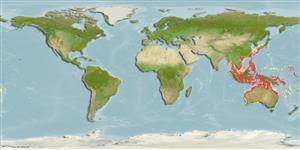Environment: milieu / climate zone / depth range / distribution range
ນິເວດວິທະຍາ
ສັດທະເລ ກ່ຽວກັນຫີນ; ລະດັບຄວາມເລິກ 1 - 55 m (Ref. 37816). Tropical
Western Pacific: Japan to Australia, including Guam and Palau.
ຂະໜາດ / ນ້ຳໜັກ / Age
Maturity: Lm ? range ? - ? cm
Max length : 30.0 cm TL ຕົວຜູ້/ບໍ່ມີເພດ; (Ref. 3132)
ຄີ (ໜາມ)ແຂງຢູ່ຫຼັງປາ (ທັງໝົດ) : 4; ຄີຫຼັງຂອງປາ (ຄີອ່ອນ) (ທັງໝົດ) : 8; ຄີ(ໜາມ) ແຂງຢູ່ຄີກົ້ນປາ
ກຸ່ມປາກະດູກແຂງ
ຄວາມຖີ່ຂອງກຸ່ມຖ່າຍທອດພັນ
ປາທີ່ມີການເຄື່ອນຍ້າຍຈາກທະເລໄປຫານ້ຳຈືດ ແລະນ້ຳຈືດຫາທະເລ
ປາທີ່ມີການເຄື່ອນຍ້າຍຈາກທະເລແລະໄປໄຂ່ຢູ່ນ້ຳຈືດ
ຄີກົ້ນຂອງປາ
ສັດທີ່ມີກະດູກສັນຫັຼງ
ການຖ່າຍທອດທາງກຳມະພັນຈາກພໍ່ແມ່ຫາລູກ: 0; ຄີກົ້ນຂອງປາ: 7. Identified by the finger-like separate first rays of the ventral fins, and distinguished from the similar D. kuiteri in usually having 8 divided rays in the second dorsal fin (versus 9), the fin with a distinct horizontal pattern of lines in adults, and males have long filaments on the first dorsal fin (versus short or absent) (Ref. 48636). Body moderately depressed. Preopercular spine with processes on both inner and outer sides. Pelvic spine and 1st pelvic ray fused into an elongate rod, separated from the other pelvic rays. Attains 10 cm SL.
Lives on sand-weed bottoms (Ref. 559). Inhabits protected sand and mud flats and slopes at depths of 1 to 55 m (Ref. 37816); also include estuaries and deep water (Ref. 48636). May be seen solitary or in pairs (Ref. 90102).
Life cycle and mating behavior
ການຈະເລີນເຕັມໄວ | ການສືບພັນ | ການວາງໄຂ່ | ໄຂ່ | ຄວາມດົກຂອງໄຂ່ປາ | ຕົວອ່ອນ
Masuda, H., K. Amaoka, C. Araga, T. Uyeno and T. Yoshino, 1984. The fishes of the Japanese Archipelago. Vol. 1. Tokai University Press, Tokyo, Japan. 437 p. (text). (Ref. 559)
IUCN Red List Status (Ref. 130435: Version 2024-2)
Threat to humans
Harmless
Human uses
ການປະມົງ: ທີ່ບໍ່ມີຄວາມສົນໃຈ; ຕູ້ປາ: ເປັນສີນຄ້າ
ເຄື່ອງມື
Special reports
Download XML
ແຫຼ່ງອີນເຕີເນັດ
Estimates based on models
Preferred temperature (Ref.
123201): 24.5 - 29, mean 28.1 °C (based on 1094 cells).
Phylogenetic diversity index (Ref.
82804): PD
50 = 0.7500 [Uniqueness, from 0.5 = low to 2.0 = high].
Bayesian length-weight: a=0.00794 (0.00362 - 0.01742), b=2.81 (2.63 - 2.99), in cm total length, based on LWR estimates for this (Sub)family-body shape (Ref.
93245).
ຊັ້ນເຂດຮ້ອນ (Ref.
69278): 3.4 ±0.5 se; based on size and trophs of closest relatives
ຄວາມຢືດຢຸ່ນ (Ref.
120179): ຂະໜາດກາງ, ປະຊາກອນຕຳ່ສຸດທີ່ໃຊ້ເວລາສອງເທົ່າ 1.4 - 4.4 ປີ (Preliminary K or Fecundity.).
Fishing Vulnerability (Ref.
59153): Low vulnerability (20 of 100).
Nutrients (Ref.
124155): Calcium = 64.2 [35.5, 96.1] mg/100g; Iron = 0.564 [0.360, 0.896] mg/100g; Protein = 18.5 [17.4, 19.4] %; Omega3 = 0.0895 [, ] g/100g; Selenium = 35 [19, 64] μg/100g; VitaminA = 85.7 [30.0, 241.4] μg/100g; Zinc = 1.4 [1.0, 1.9] mg/100g (wet weight);
